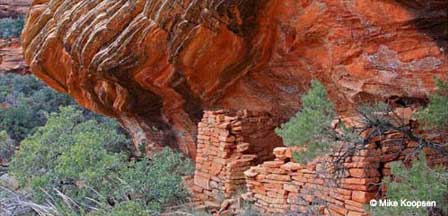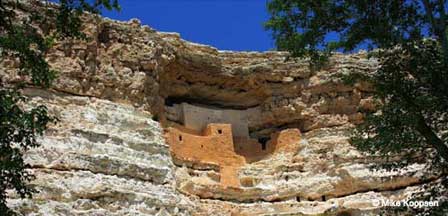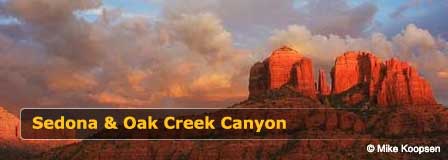Native Americans of the Sedona Region
The native influence on the Sedona area dates far back to when Paleo-Indians began to penetrate North America from Asia some twenty-five thousand years ago. Europeans would not begin to settle in Sedona until the late nineteenth century. Today, the Native American influence on Sedona is unmistakable and profound. Visitors traveling to Sedona may find remarkable traces of these first settlers of the land in everything from remote rock paintings to present-day arts and crafts.

Sedona's Native American History
The area's prehistory still has many gaps, but even so, archaeologists have made many astounding discoveries about the first inhabitants of the Sedona region. The first Asians who crossed the Bering Strait during the last Ice Age and headed south must have been searching for a more hospitable climate. Eleven thousand years ago, archaeologists suspect that nomadic people of the Sedona region were most-likely hunting Ice Age beasts and gathering wild plants.
The culture of the Paleo-Indians began to change significantly about seven thousand years ago. Referred to as the Archaic culture, these native peoples began to rely more on the gathering of plants and hunted smaller game-modern animals that we are familiar with today. Archaeologists have uncovered Archaic projectile points and stone tools in Sedona's Red Rock Country near Dry Creek.

Although the Archaic culture of the region evolved, it did not substantially alter until 700 AD when it was replaced with a native culture that practiced farming and created pottery. This group is referred to as the Hakataya who were soon joined by another group called the Hohokam. After another group, the Sinagua, moved into the region, the merged people of the area are referred to as the Southern Sinagua. Evidence of their life can be found in Sedona's cliff dwellings and rock art sites that depict ancient petroglyphs. One fine example of a cliff dwelling can be found off Red Canyon in Red Rock Country and is known as the Palatki cliff dwelling.
Sedona's Modern Native American Presence
It is not known why the Southern Sinagua abandoned the Sedona region, but they appeared to have departed by the middle of the fifteenth century. However, over the subsequent centuries, Sedona's current modern-day Native cultures moved into the region: the Yavapai and the Tonto Apaches. There is also a strong influence from Navajo and Hopi Indians. Archaeologists believe the Hopi ancestors may actually have been the Southern Sinagua peoples.
While many agree that Native populations of the Southwest suffered greatly as European law began to dominate the region, few would argue the lasting impact that Native American culture has given to the Sedona region. Their rich cultural impact is felt many facets of Sedona life from their stewardship and respect for the land to their powerful ceremonies and artistic contributions.
Native American Sites of Sedona
Travelers will thrill to view the ancient past that is preserved on the walls of Sedona's rocks. Woo Canyon's pictograph panel is a well-preserved example of ancient Native art that shows pictographs of people and animals. Woo Canyon is an offshoot of Red Canyon that is about a half mile south of the Palatki site. Sedona's largest cliff dwelling is called Honanki and was presumably constructed by the Southern Sinagua roughly eight hundred years ago. Archaeologists believe that Honanki was once home to nearly four hundred inhabitants.
Modern Native American Culture in Sedona
Native American culture is alive and well in present-day Sedona. Visitors will inevitably share their long-established reverence for the land. Just as they hold many places around Sedona to be sacred, travelers will doubtlessly find their reverence to be well placed. There are many fine examples of Native American artistry in Sedona's galleries and shops. Native American pottery and jewelry are some of the most popular items for visitors. However, Native American music and dance are often showcased at various venues and all interested parties should consider booking one of Sedona's Native American tours to visit the sites and learn more about the historic people of this region.
Getting There
Sedona is located twenty-seven miles south of Flagstaff on AZ 89A. The area encompasses some 500 square miles of central Arizona and its regions are divided into Red Rock Country, Oak Creek Canyon, and greater Sedona.
Additional Sedona Area Information
Map & Directions Oak Creek Trail
Oak Creek Canyon Map & Directions
Oak Creek Canyon Photos By Koopsen
Oak Creek Canyon Vista Point
Sedona Aerial Photos By Koopsen
Sedona Winter Photos By Koopsen
Verde Canyon Railroad
The Wonder Of Sedona & Oak Creek
Sedona-Oak Creek Canyon
Sedona Arizona
Oak Creek Canyon
Arizona Route 66
Map & Directions
Weather & Climate
Sedona Pictures
Things To Do
Public Golf Courses
Grand Canyon Tours
West Fork Trail
Desert Canyon Drive
Sedona Museums
Events & Festivals
Jeep & Hummer Tours
Horseback Riding
Area Attractions
Palatki Indian Ruins
Montezuma Castle
Montezuma Well
Grand Canyon South Rim
Sycamore Canyon
Slide Rock State Park
Grand Canyon Railway
Chapel of the Holy Cross
Oak Creek
Nearby Towns
Flagstaff Arizona
Jerome Arizona
Cornville Arzona
Williams Arizona
Cottonwood Arizona
Sedona Articles
Native American History
Vortex Visions
Mystical Vortexes
Enchantment Resort
Credit The Sinagua
Where To Stay
Cabins & Lodges
RV Parks & Campgrounds
Bed and Breakfast
Sedona Vacation Rentals
Sedona Timeshares















